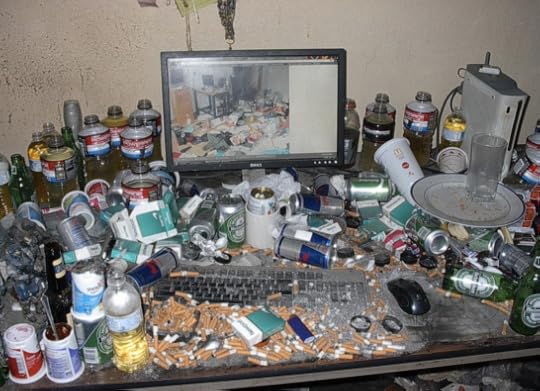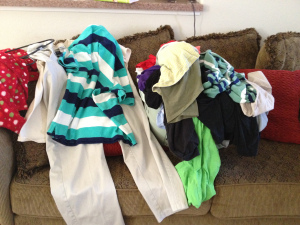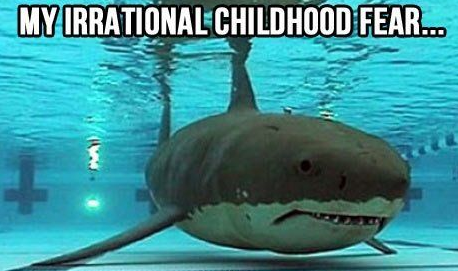Setting—Why a Picture is Worth a Thousand Words

Hmmmm. Must be Walmart.
Today we are going to talk about setting and ways to use it to strengthen your writing and maybe even add in some dimension. Setting is more than a weather report. It can be a magnificent tool to deepen characters.
Setting Can Help Your Characterization
Setting can actually serve a dual role in that it can be not only the backdrop for your story, but it can also serve characterization through symbol.
We editors love to say, “Show. Don’t tell.” Okey dokey, here’s where setting can help you do just that.

THAT’S a desk with a story. “The menthol brings out the blueberry notes in the Yoplait…”
Say you have a character, Buffy, who is depressed. You could go on and on telling us she is blue and how she cannot believe her husband left her for the Scentsy lady, OR you can show us through setting.
Buffy’s once beautiful garden is overgrown with weeds and piles of unopened mail are tossed carelessly on the floor. Her house smells of almost-empty tubs of chocolate ice cream left to sour. Piles of dirty clothes litter the rooms, and her cat is eating out of the bag of Meow Mix tipped on its side.
Now you have shown us that Buffy is not herself. We know this because the garden was “once beautiful.” This cues me (the reader) that something has changed. And you managed to tell me she was depressed without dragging me through narrative in Buffy’s head.
She couldn’t believe Biff was gone. Grief surged over her like a surging tidal surge that surged.
Writing is therapeutic, not therapy. Some of that introspection is great, but after a while you will wear out your readers. Setting can help alleviate this problem and keep the momentum of your story moving forward. We will get that Buffy is depressed by getting this glimpse of her house. You have shown that Buffy is having a rough time instead of being lazy and telling us.

Buffy needs to get a grip.
We judge people by their environment. Characters are no different.
If you want to portray a cold, unfeeling schmuck, then when we go to his apartment it might be minimalist design. No color. No plants or signs of life. Someone who is scatter-brained? Their house is full of half-finished projects. An egomaniac? Walls of plaques and pictures of this character posing with important people. Trophies, awards, and heads of dead animals. You can show the reader a lot about your character just by showing us surroundings.
Trust me, if a character gets out of her car and five empty Diet Coke bottles fall out from under her feet into her yard that is littered with toys, we will have an impression.
Probably the single largest mistake I see in the work of new writers is that they spend far too much time in the sequel.
What is the Sequel?
Plots can be broken into to main anatomical parts–scene and sequel. The scene is where the action occurs. A goal is declared and some disastrous setback occurs that leaves our protagonist worse off than when he began. Generally, right after this disaster there is what is called the sequel.
The sequel is the emotional thread that ties all this action together.
Yet, too often new writers will go on and on and on in a character’s head, exploring and probing deep emotions and nothing has yet happened. The sequel can only be an effect/direct result of a scene. Ah, but here comes the pickle. How can a writer give us a psychological picture of the character if he cannot employ the sequel?
Setting.
An example? In Silence of the Lambs how are we introduced to Hannibal Lecter? There is of course the dialogue that tells Agent Starling that Dr. Lecter is different, but talk is cheap, right? Clarice goes down into the bowels of a psychiatric prison to the basement (um, symbol?). She walks past cell after cell of the baddest and the maddest. All of them are in brick cells with bars…until Clarice makes it to the end.

Hannibal’s cell is not like the others. He is behind Plexi-Glass with airholes. This glass cage evokes a primal fear. Hannibal affects us less like a prisoner and more like a venomous spider. Setting has shown us that Hannibal the Cannibal is a different breed of evil. This is far more powerful than the storyteller poring on and on and on about Hannibal’s “evil.”
Setting Can Set or Amplify Mood

Either you can use setting to mirror outwardly what is happening with a character, or you can use it as a stark contrast. For instance, I once edited a medieval fantasy. In the beginning the bad guys were burning villagers alive. Originally the writer used a rainy, dreary day, which was fine. Nothing wrong with that.
I, however, suggested she push the envelope and go for something more unsettling. I recommended that she change the setting to sunny and perfect weather. In the heart of the village the ribbons and trappings of the spring festival blew in the gentle breeze, the same breeze that now carried the smell of her family’s burning flesh.
Sometimes it is this odd juxtaposition in setting that can evoke tremendous emotion.
Think about how you felt watching the scene in Terminator 2 where the nuke goes off and obliterates a playground.
This tactic is especially useful in horror. Dead bodies are upsetting. Dead bodies at a church picnic are an entirely new level of disturbing.
Setting is a Matter of Style and Preference
Different writers use setting in different ways and a lot of it goes to your own unique voice. Some writers use a lot of description, which is good in that there are readers who like a lot of description. But there are readers who want you to get to the point, and that’s why they generally like to read works by writers who also like to get to the point. Everyone wins.
Whether you use a lot or a little setting will ultimately be up to you. I would recommend some pointers.
Can your setting symbolize something deeper?

I challenge you to challenge yourself. Don’t just pick stormy weather because it is the first image that pops in your mind. Can you employ setting to add greater dimension to your work? Using setting merely to forecast the weather is lazy writing. Try harder.
In Shutter Island, Dennis Lehane’s story is set on an island at a prison for the criminally insane. What the reader finds out is the prison is far more than the literal setting; it is a representation for a state of mind. The protagonist, U.S. Marshal Teddy Daniels is imprisoned by his own guilt and need for justice.
Like the island, he too is cut off from the outside world emotionally and psychologically. Now an island is more than an island, a prison is more than a prison, bars are more than bars, cliffs are more than cliffs, storms are more than storms, etc. Shutter Island is an amazing book to read, but I recommend studying the movie for use of setting as symbol.
So dig deeper. Can you get more out of your setting than just a backdrop?
Blend setting into your story.

When I teach, I liken setting to garlic in garlic mashed potatoes. Blend. Garlic is awesome and enhances many dishes, but few people want a whole mouthful of it. Make sure you are keeping momentum in your story. Yes, we generally like to be grounded in where we are and the weather and the time of year, but not at the expense of why we picked up your book in the first place…someone has a problem that needs solving.
Unless you are writing a non-fiction travel book, we didn’t buy your book for lovely description of the Rocky Mountains. We bought it to discover if Ella May will ever make it to California to meet her new husband before winter comes and traps her wagon train in a frozen world of death.
Keep perspective and blend. Keep conflict and character center stage and the backdrop in its place…behind the characters. Two fantastic resources to help you with setting are The Urban Setting Thesaurus and The Rural Setting Thesaurus by Angela Ackerman and Becca Puglisi. Do yourself a favor and just buy both of those today.
In the end, setting will be a huge reflection of your style and voice, but I hope this blog has given some insight that might make you see more to your use of setting and help you grow to be a stronger writer. What are some books or movies that really took setting to the next level? How was setting used? How did it affect you?
I love hearing from you!
To prove it and show my love, for the month of JUNE, everyone who leaves a comment I will put your name in a hat. If you comment and link back to my blog on your blog, you get your name in the hat twice. What do you win? The unvarnished truth from yours truly. I will pick a winner once a month and it will be a critique of the first 20 pages of your novel, or your query letter, or your synopsis (5 pages or less).
Check out classes below!
Upcoming Classes
All W.A.N.A. classes are on-line and all you need is an internet connection. Recordings are included in the class price.
Again, I am trying something new and offering an open and interactive workshop. Is your first page strong enough to withstand the fire?
So You Want to Write a Novel TONIGHT!!!!!
June 17th, 7-9 EST. Cost is $35
Just because we made As in high school or college English does not instantly qualify us to be great novelists. Writing a work that can span anywhere from 60,000 to 120,000+ words requires training. This class is for the person who is either considering writing a novel or who has written a novel(s) and is struggling.
We will cover the essentials of genre, plot, character, dialogue and prose. This class will provide you with the tools necessary to write lean and clean and keep revisions to a minimum.
Character & Plotting (NEW CLASS!)
June 24th, 2015 7:00-9:00 P.M. EST. Cost is $35
All great plots are birthed from character. The core plot problem should be the crucible that eventually reveals a hero in Act III. This means that characterization and plot are inextricably linked. Weak plot, weak character. Blasé character, blasé plot.
This class will teach you how to create dimensional characters and then how to plot from inner demons and flaws. Get inside the heads and hearts of your characters in a way that drives and tightens dramatic tension.
This is an excellent class for anyone who wants to learn how to plot faster and to add layers to their characters.
For those who need help building a platform and keeping it SIMPLE, pick up a copy of my latest social media/branding book Rise of the Machines—Human Authors in a Digital World on AMAZON, iBooks, or Nook.





